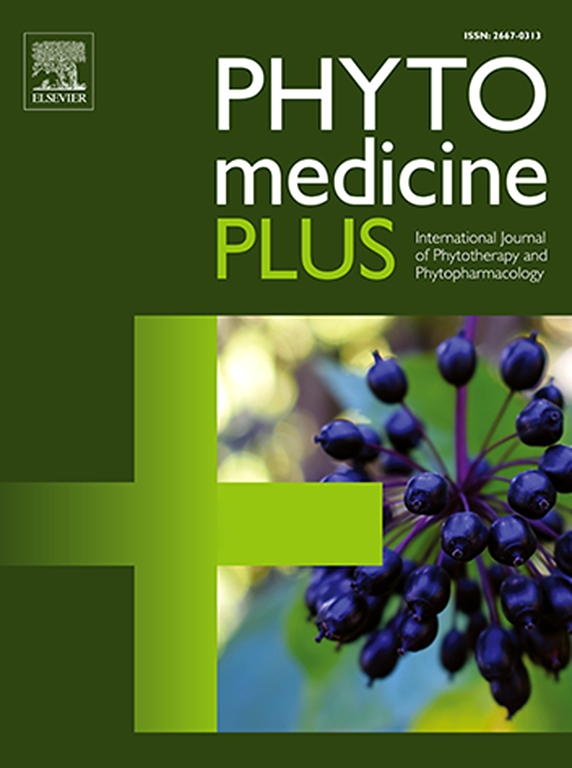Neuroprotective role of epigallocatechin-3-gallate, albeginin and melanoxetin in alzheimer's disease
Q3 Pharmacology, Toxicology and Pharmaceutics
引用次数: 0
Abstract
Background
Alzheimer's disease (AD) is a heterogeneous and progressive neurodegenerative disorder characterized by cognitive impairment and behavioral disturbances. Phytochemicals are considered safer alternatives and have shown significant efficacy in inhibiting cholinesterase, scavenging free radicals, inhibiting amyloid-β neurotoxicity, reducing inflammation, and interacting with neurotransmitters, thereby slowing down the progression of AD.
Purpose
EGCG, is an antioxidant/anti-inflammatory that lowers amyloid-b and tau aggregation in AD models and improves cognition at preclinical dosages of 25–100 mg/kg/day and clinical doses of 200–800 mg/ Albeginin, a new flavonoid, reduces neuroinflammation in rats at 10–50 mg/kg/day, equal to 100–200 mg/day in humans. Melanoxetin, a phenolic molecule, chelates toxic metals, lowers ROS, and protects neurons at 15–40 mg/kg/day in animal models and 50–150 mg/day in humans. These chemicals show promise for Alzheimer's treatment.
Study design
The study targeted specific AD-related proteins, including acetylcholinesterase (AChE), alpha serine/threonine-protein kinase (AKT-1), β-secretase-1 (BACE-1), cyclooxygenase-2 (COX-2), caspase-3, glycogen synthase kinase-3 (GSK-3), interleukin-6 (IL-6), mitogen-activated protein kinase-2 (MAPK-2), matrix metalloproteins-8 (MMP-8), N-methyl-d-aspartate receptor (NMDAR), Peptidyl arginine deiminase-2 (PAD-2), Presenilin-1 (PSEN-1), mitogen-activated protein kinase-14 (MAPK-14/P38), and tumor necrosis factor-alpha (TNF-α).
Methods
Before conducting experimental work, molecular dynamic (MD) simulations were performed to assess the binding affinity of EGCG, albeginin, and melanoxetin against the selected targets. Sprague Dawley rats were injected with colchicine to induce AD, followed by treatment with the selected phytocompounds for three weeks.
Results
In silico results indicated strong binding interactions of EGCG, albeginin, and melanoxetin with the target proteins. The rats treated with these phytocompounds showed a significant reduction in oxidative stress, inflammation, Aβ plaque formation, neurofibrillary tangles, and anticholinesterase activity.
Conclusion
This is the first comprehensive study on the therapeutic role of EGCG, albeginin, and melanoxetin against AD. These phytocompounds demonstrate potential for better management of AD in the future.

表没食子儿茶素-3-没食子酸酯、albeginin和melanoxetin在阿尔茨海默病中的神经保护作用
阿尔茨海默病(AD)是一种异质性进行性神经退行性疾病,以认知障碍和行为障碍为特征。植物化学物质被认为是更安全的替代品,在抑制胆碱酯酶、清除自由基、抑制淀粉样蛋白-β神经毒性、减少炎症和与神经递质相互作用方面显示出显著的功效,从而减缓了AD的进展。egcg是一种抗氧化/抗炎药物,临床前剂量为25-100 mg/kg/天,临床剂量为200-800 mg/kg/天,egcg可以降低AD模型中的淀粉样蛋白b和tau聚集,改善认知,Albeginin是一种新的类黄酮,10-50 mg/kg/天可以减轻大鼠的神经炎症,相当于100-200 mg/天。黑素西汀是一种酚类分子,可以螯合有毒金属,降低活性氧,并在动物模型中以15-40 mg/kg/天和在人类中以50-150 mg/天的剂量保护神经元。这些化学物质有望治疗阿尔茨海默氏症。研究针对ad相关的特异性蛋白,包括乙酰胆碱酯酶(AChE)、α -丝氨酸/苏氨酸蛋白激酶(AKT-1)、β-分泌酶-1 (BACE-1)、环氧化酶-2 (COX-2)、caspase-3、糖原合成酶激酶-3 (GSK-3)、白介素-6 (IL-6)、丝裂原活化蛋白激酶-2 (MAPK-2)、基质金属蛋白-8 (MMP-8)、n-甲基-d-天冬氨酸受体(NMDAR)、肽基精氨酸脱亚胺酶-2 (PAD-2)、早老素-1 (PSEN-1)、丝裂原活化蛋白激酶-14 (MAPK-14/P38)、肿瘤坏死因子-α (TNF-α)。方法在开展实验工作之前,通过分子动力学(MD)模拟来评估EGCG、albeginin和melanoxetin对选定靶点的结合亲和力。给Sprague Dawley大鼠注射秋水仙碱诱导AD,然后用选定的植物化合物治疗三周。结果结果显示EGCG、albeginin和melanoxetin与靶蛋白有较强的结合作用。用这些植物化合物治疗的大鼠显示出氧化应激、炎症、a β斑块形成、神经原纤维缠结和抗胆碱酯酶活性的显著降低。结论EGCG、albeginin和melanoxetin治疗AD的综合研究尚属首次。这些植物化合物显示出在未来更好地管理AD的潜力。
本文章由计算机程序翻译,如有差异,请以英文原文为准。
求助全文
约1分钟内获得全文
求助全文
来源期刊

Phytomedicine Plus
Medicine-Complementary and Alternative Medicine
CiteScore
3.70
自引率
0.00%
发文量
178
审稿时长
81 days
期刊介绍:
 求助内容:
求助内容: 应助结果提醒方式:
应助结果提醒方式:


